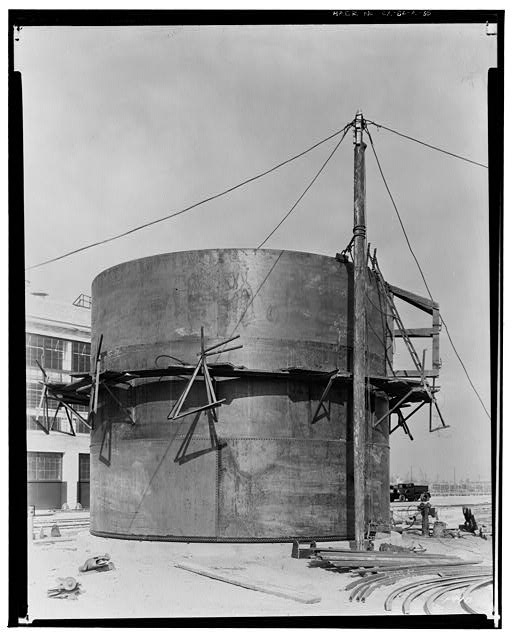Ford Long Beach Assembly Plant Pressed Steel Technology
When the Long Beach Ford plant first opened, the facility consisted only of the assembly building, offices and warehouse. Soon, however, the pressed steel building was added.
"Pressed Steel" according to a 1931 article by J. K. Frazee, means making fenders, hoods and like sheet metal parts. The raw material for this process are sheets of steel approximately one thirty-second of an inch thick which is sent to Long Beach on Ford's ships. The plant is equipped with conveyors for moving the work from one machine to another.
The machines used to press this steel are some of the heaviest and most expensive machinery that mass automobile production used at that time. One machine, for example, cost $50,000. Managers of the Ford Motor Company decided to make pressed steel parts in Long Beach to supply the local plant and others on the west coast in San Francisco, Portland and Seattle as well as overseas plants In Asia. The one at Long Beach was Ford's only pressed steel plant in the United States outside of the main factory in Michigan.
The unit at Long Beach used eight presses and shears, and contained a bonderizing department and a large die maintenance section. That last department was naturally of great importance, in view of the size, accuracy and cost of the dies required for these huge machines.
Seven different parts of pressed steel were made including front and rear fenders, running board and front splash shields, fender aprons and reinforcements, and hoods. One of the largest presses in the Long Beach plant, according to Frazee, made front fenders. It weighed 125 tons, used a 17 ton die, operated at 25 tons pressure and worked to one 4,000 part of an inch tolerance. He also noted that the smallest machine in the plant was the hardest to operate. It wired fenders for reinforcement and workers who ran it needed six months of training. The most complicated parts to make were rear fenders; they required 20 different operations and the accurate spacing of holes, brackets and an attached apron. Making the hood required eighteen operations. Running-board shields were pressed by an enormous device which made two at once forming the fender well, front splash shield and fender reinforcement with three separate dies.
After the steel parts were pressed, they were Bonderized. Bonderizing is a treatment by which a material called bonderite gives the pressed steel parts a chemical rust-proofing. From the presses, parts went to a large tank where they were washed clean, and then into the rust-proofing solution. The process prevents rust forming should the enamel be scratched in service. Parts made in Long Beach to be shipped to other branch plants were sent right after they were Bonderized. Parts are not enameled until they reach the plant where they are to be assembled into cars. This avoids possible scratching during shipping.
Steel pressing at Long Beach began in the fall of 1930 when the building designed for it opened. In December, 1932, both the steel pressing operation and the assembly line were closed and from January, 1933 to December, 1934, the building served only as a sales and service center. When the building again began operation as an assembly plant, steel pressing operations were not resumed. The steel pressing equipment had been shipped back to Ford’s Rouge River plant in September, 1934. The space that had been devoted to steel pressing was taken over to serve as part of the assembly floor.

PRESSED STEEL BUILDING, PRESSED STEEL MACHINERY

PRESSED STEEL BUILDING, EAST SIDE, SHOWING EXTERIOR OF THE BONDERITE TANK
More Pictures
Office and Pressed Steel Buildings
Interior Pressed Steel Building
Interior Pressed Steel Building 2
Pressed Steel Building Plans